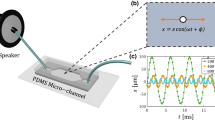Abstract
Low levels of kinetic energy dissipation were successfully generated in a reactor using two submersible speakers. A software programme controlled the amplitude and frequency of the signal fed to each speaker and achieved good repeatability of flow conditions. The flow reactor had a near isotropic flow regime with a low mean flow, values were calculated from particle image velocimetry measurements. The flow characteristics compared well with grid turbulence reactors, though as no moving parts are present in this reactor design the strain rates were lower compared to oscillating grid set-ups. The low range of Reynolds numbers based on Taylor microscales (Re λ~0.5–5.9) covered both turbulent and non-turbulent flow regimes. The small-scale fluid motion produced over the entire volume of this reactor makes it suitable for experiments examining the physiological responses of fluid motion on microorganisms.
Similar content being viewed by others
References
Alcaraz M., Marrasé C., Peters F., Arin L. and Malits A. (2002). Effects of turbulence conditions on the balance between production and respiration in marine planktonic communities. Marine Ecology Progress Series 242: 63–71
Baldi S. and Yianneskis M. (2003). On the direct measurement of the turbulence energy dissipation in stirred vessels with PIV. Industrial and Engineering Chemistry Research 42: 7006–7016
Batchelor G.K. (1960). The theory of Homogeneous turbulenc. Cambridge University Press, Cambridge
Bergstedt M.S., Hondzo M. and Cotner J.B. (2004). Effects of small scale fluid motion on bacterial growth and respiration. Freshwater Biology 49: 28–40
Birouk M., Sarh B. and Gökalp I. (2003). An attempt to realize experimental isotropic turbulence at low Reynolds number. Flow, Turbulence and Combustion 70: 325–348
Fernando H.J.S. (1994). Oscillating grids as a source of nearly isotropic turbulence. Physics of Fluids 6: 2455–2464
Doron P., Bertuccioli L. and Katz J. (2001). Turbulence characteristics and dissipation estimates in the coastal ocean bottom boundary layer from PIV data. Journal of Physical Oceanography 31: 2108–2134
Estrada M. and Berdalet E. (1997). Phytoplankton in a turbulent world. Scientia Marina 61(Supp. 1): 125–140
Fallon T. and Rogers C.B. (2002). Turbulence-induced preferential concentration of solid particles in microgravity conditions. Experiments in Fluids 33: 233–241
Gibson C.H. and Thomas W.H. (1995). Effects of turbulence intermittency on growth inhibition of a red tide dinoflagellate, Gonyaulax polyedra Stein. Journal of Geophysical Research 100: 24841–24846
Grobbelaar J.U. (1994). Turbulence in mass algal cultures and the role of light/dark fluctuations. Journal of Applied Phycolgy 6: 331–335
Hinze, J.O., 1975. Turbulence, 2nd edn., McGraw-Hill Book Company, Inc., New York
Hwang W and Eaton J.K. (2004). Creating homogeneous and isotropic turbulence without a mean flow. Experiments in Fluids 36: 444–454
Jiménez J. (1997). Oceanic turbulence at millimetre scales. Scientia Marina 61(Supp. 1): 47–56
Karp-Boss L., Boss E. and Jumars P.A. (1996). Nutrient fluxes to planktonic osmotrophs in the presence of fluid motion. Oceanography and Marine Biology: an Annual Review 34: 71–107
Kiørboe T. (1993). Turbulence, phytoplankton cell size and the structure of the pelagic food webs. Advances in Marine Biology 29: 1–61
Kolmogorov A.N. (1941). The local structure of turbulence in incompressible viscous fluids at very large Reynolds numbers. Dolk. Nauk. SSSR 30: 301–305 (Reprinted in English, 1991, in Proceedings of the Royal Society of London 434: 9–13)
MacKenzie B. R. and Kiørboe T. (1995). Encounter rates and swimming behavior of pause-travel and cruise larval fish predators in calm and turbulent laboratory environments. Limnology and Oceanography 40: 1278–1289
Nimmo Smith W.A.M., Atsavapranee P., Katz J. and Osborn T.R. (2002). PIV measurements in the bottom boundary layer of the coastal ocean. Experiments in Fluids 33: 962–971
O’Brien K., Meyer D.L., Waite A.M., Ivey G.N. and Hamilton D.P. (2004). Disaggregation of Microcystis aeruginosa colonies under turbulent mixing: laboratory experiments in a grid-stiffed tank. Hydrobiologia 519: 143–152
Pasciak W. and Gavis J. (1975). Transport limited nutrient uptake rates in Ditylum brightwellii. Limnology and Oceanography 20: 604–617
Peters F. and Marrasé C. (2000). Effects of turbulence on plankton: an overview of experimental evidence and some theoretical considerations. Marine Ecology Progress Series 205: 291–306
Pope S.B. (2000). Turbulent flows. University Press, Cambridge
Prasad A.K. (2000). Particle image velocimetry. Current Science 79: 51–60
Regel R.H., Brookes J.D., Ganf G.G. and Griffiths R.W. (2004). The influence of experimentally generated turbulence on the Marsh01 unicellular Microcystis aeruginosa strain. Hydrobiologia 517: 107–120
Tennekes H. and Lumley J.L. (1972). A First Course in Turbulence. The MIT Press, Cambridge, MA, USA
Thomas W.H. and Gibson C.H. (1990). Effects of small-scale turbulence on micro-algae. Journal of Applied Phycology 2: 71–77
Thomas W.H., Vernet M. and Gibson C.H. (1995). Effects of small-scale turbulence on photosynthesis, pigmentation, cell division and cell size in the marine dinoflagellate Gonyaulax polyedra (Dinophyceae). Journal of Phycology 31: 50–59
Uberoi M. and Wallis S. (1967). Effect of grid geometry on turbulence decay. Physics of Fluids 10: 1216–1224
Webster D.R., Brathwaite A. and Yen J. (2004). A novel laboratory apparatus for simulating isotropic oceanic turbulence at low Reynolds number. Limnology and Oceanography Methods 2: 1–12
Yamazaki, H., D.L. Mackas & K.L. Denman, 2002. Coupling small-scale physical processes with biology. In Robinson A.R., J.J. McCarthy & B.J. Rothchild (eds.), The Sea. Volume 12, John, Inc. New York: 51–112
Author information
Authors and Affiliations
Corresponding author
Rights and permissions
About this article
Cite this article
Warnaars, T.A., Hondzo, M. & Carper, M.A. A Desktop Apparatus for Studying Interactions Between Microorganisms and Small-Scale Fluid Motion. Hydrobiologia 563, 431–443 (2006). https://doi.org/10.1007/s10750-006-0030-6
Received:
Revised:
Accepted:
Published:
Issue Date:
DOI: https://doi.org/10.1007/s10750-006-0030-6




